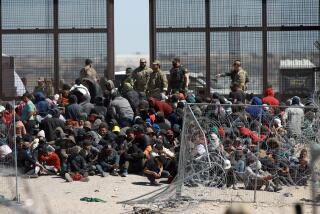Editorial: Brown says ‘yes’ to Trump’s lame-brained National Guard border deployment. Here’s why he’s right

President Trump’s decision to deploy National Guard troops to the U.S.-Mexican border is as lame-brained as his insistence on building an $18-billion wall between the two countries. It’s pure theater aimed at his xenophobic supporters, a follow-up to his histrionic tweetings about the much-hyped caravan of migrants that was heading north to the border.
The caravan has since disbanded. But the president is still fuming and fear mongering, and his fix is to pound his chest, bluster and call out the National Guard to augment the work of federal Border Patrol agents. To many people’s surprise, Gov. Jerry Brown acquiesced to the commander-in-chief’s request and will add 400 California guardsmen to an existing deployment of 250 — only 55 of whom are near the border. Trump was wrong to make the request, but Brown was right to honor it.
Presidents have deployed the National Guard to the border before — President Obama did so in 2010 and President Bush in 2006. Obama’s deployment was in response to demands from congressional Republicans that border security be strengthened as a precursor to discussions over immigration reform, and to help address a staffing shortage as Customs and Border Protection officials hired more agents. Bush sent out members of the Guard as a political move to signal that he was firming the border against illegal immigration. But in both cases — and this will be true for the guards sent out by Trump as well — they were barred from actual civil law enforcement, including interdiction of people crossing the border. They will be limited to offering support, equipment and surveillance.
It sets a bad precedent if governors refuse to comply with a call-out request on political grounds.
Trump larded his order with his usual hyperbole. “The situation at the border has now reached a point of crisis,” he said in his declaration. “The lawlessness that continues at our southern border is fundamentally incompatible with the safety, security, and sovereignty of the American people. My administration has no choice but to act.” Yet illegal border crossings by migrants remain at modern-era lows. And while drug smuggling continues, there’s little in federal data to suggest a big surge in criminality — though the Texas Tribune reported earlier this year that enhanced border security and the threat of a wall has driven up profits for the smugglers.
Despite the silliness of the president’s request, Brown agreed to send 400 California troops. As a counterweight to Trump’s braggadocio, Brown included a restatement of the limitations under which the National Guard troops will work, and lectured the president on his immigration policies. “This will not be a mission to build a new wall,” Brown wrote. “It will not be a mission to round up women and children or detain people escaping violence and seeking a better life. And the California National Guard will not be enforcing federal immigration laws. Here are the facts: There is no massive wave of migrants pouring into California.”
Brown struck the correct tone. Trump is an awful president, but he remains commander in chief, and as such, his request for National Guard deployments must be taken seriously. Brown, as governor, has the authority to refuse to comply, but that could quickly escalate and end with the president federalizing the guard units and deploying them anyway. That might make for good showboating, but it sets a bad precedent if governors refuse to comply with a call-out request on political grounds.
Brown avoided a showdown, ceded little, and fulfilled his obligation as the state’s top executive to respond to a lawful (if stupid) request from the president. Sending the National Guard to the border is stagecraft, not security, and could cost federal taxpayers $400 million while disrupting the lives of the National Guard troops. Most people living here without authorization didn’t sneak in over the border, but came in legally and then didn’t leave when their visas expired. And drug smugglers move more contraband through ports of entry than by slipping across the border. The first step in finding a solution to a problem is understanding the issue. Trump continues to show that he either doesn’t understand or cynically misconstrues the problem, and that he has no idea how to craft workable solutions.
Follow the Opinion section on Twitter @latimesopinion or Facebook
More to Read
A cure for the common opinion
Get thought-provoking perspectives with our weekly newsletter.
You may occasionally receive promotional content from the Los Angeles Times.






